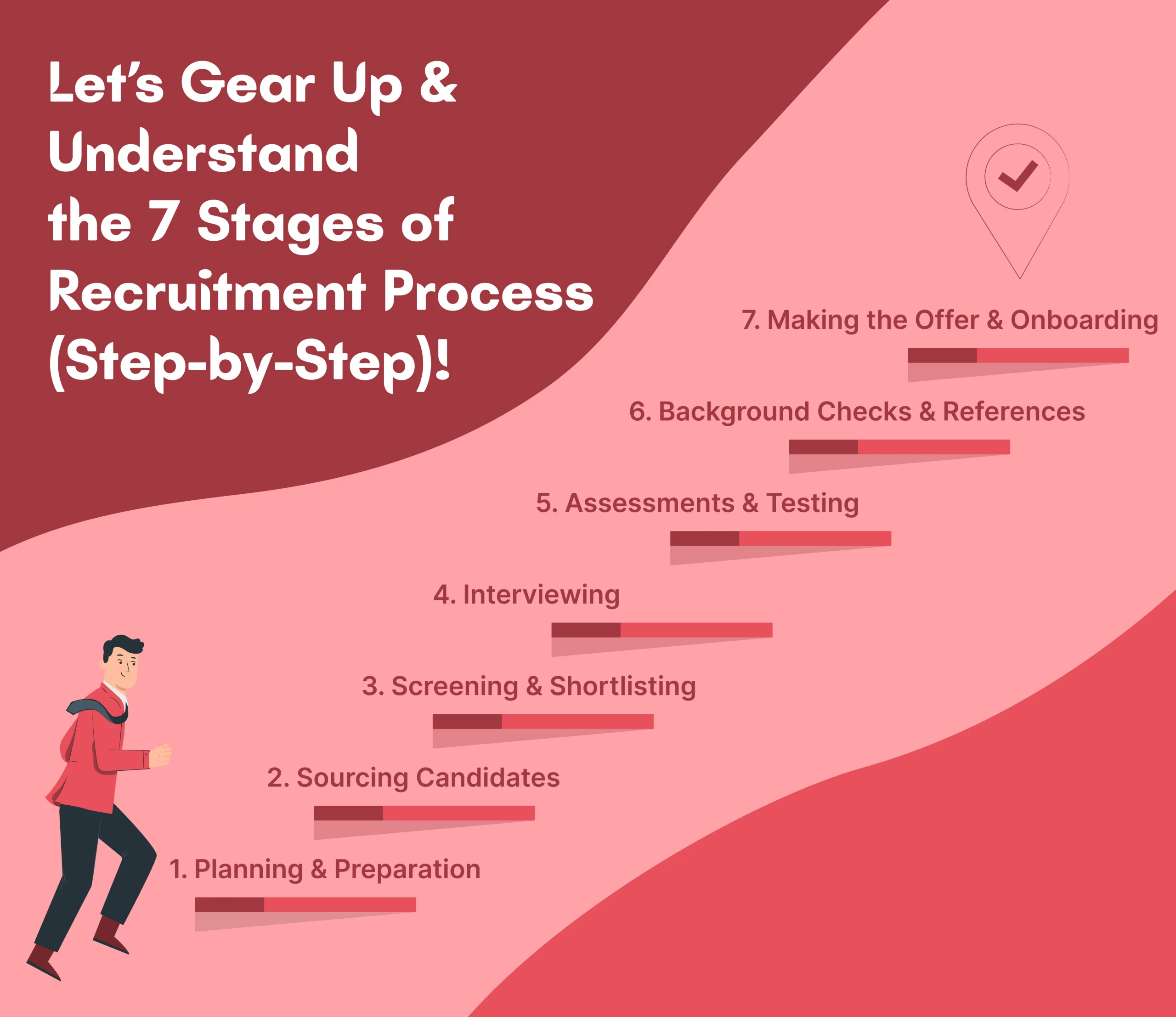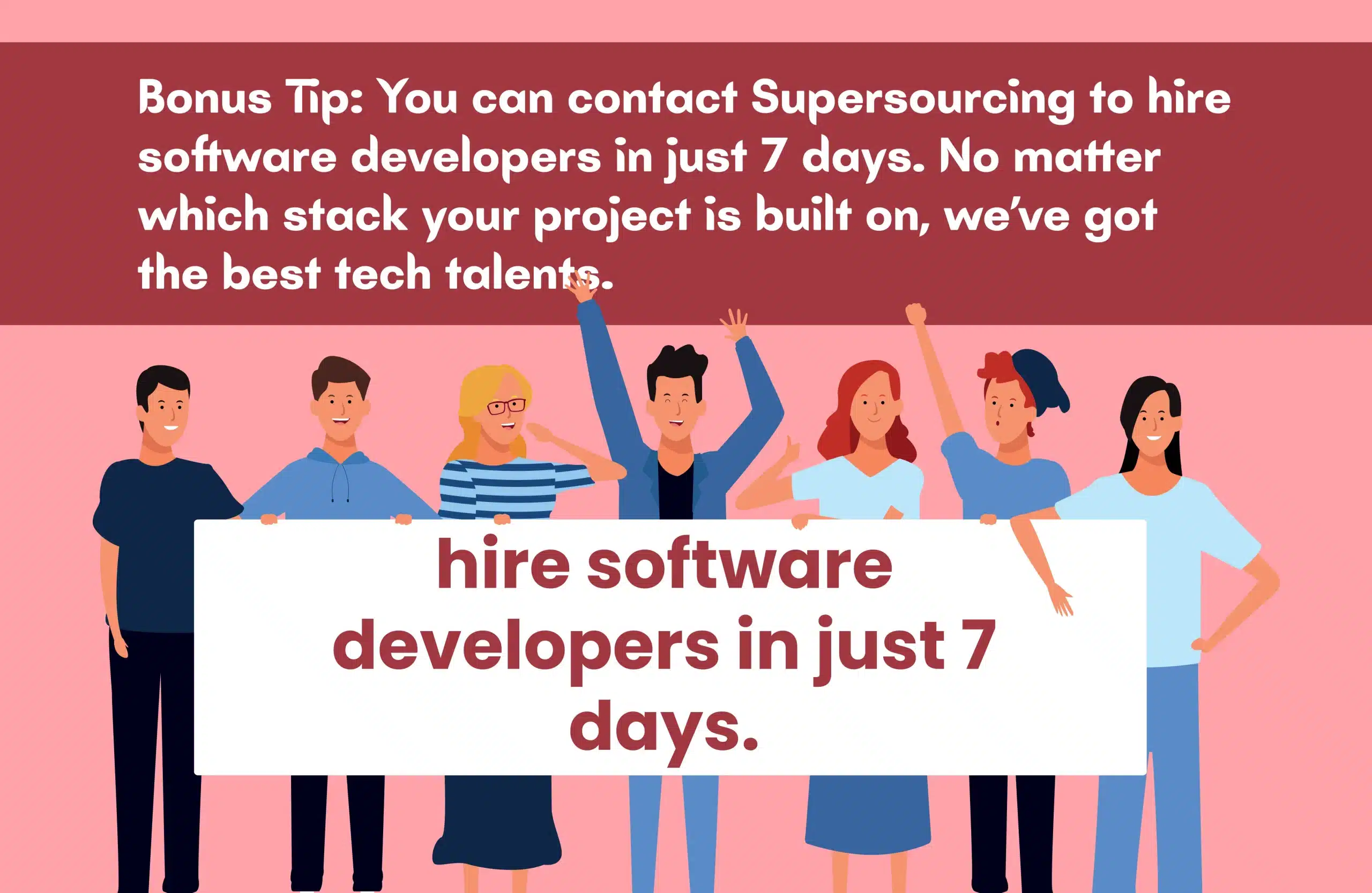Table of content
You would undoubtedly mention the recruitment process, and that’s obviously true! When you want to change the result, you’ll need to change the process.Ever since I entered the hiring industry, I have observed the importance of mastering the recruitment process.
This is not just a theoretical concept but a personal journey I’ve been on, and I’m here to share my insights with you.From attracting the best candidate for the required position to retention, this blog will explore all the 7 stages of recruitment process you need to master. Consequently, it will equip you with the knowledge you need to hire the right candidates and reduce the
time to hire, resulting in HAPPY HIRING!Bonus tip: If your recruitment team is facing challenges in hiring the best candidates on the market, you can also consider talent acquisition outsourcing
Let’s Explore the 7 Stages of Recruitment Process (Step-by-Step)!
Recruitment is finding and hiring the best candidates for a job. It involves several key steps to ensure the right person is chosen for the right role. Here’s a step-by-step guide to understanding the 7 stages of the recruitment process:
Stage 1: Planning and Preparation
Before starting the recruitment process, it’s essential to plan and prepare. This involves identifying the need for a new hire, defining the job role, and creating a detailed job description. The job description should outline the responsibilities, required skills, and qualifications. This step helps ensure that everyone involved understands what is needed from the new hire.
Here’s how you can enhance the efficiency of this stage:
- Develop a detailed job description: Craft a job description that goes beyond a generic list of duties. Focus on creating a clear and concise description that highlights the essential skills, experience, and qualifications needed for the role. This precision helps attract candidates who are truly suitable, saving time on sifting through unqualified applicants.
- Define the ideal candidate profile: Think deeply about the qualities and personality traits that would make someone a perfect fit for your team and company culture. Consider not only the technical skills required but also the soft skills and cultural alignment. A clear picture of the ideal candidate will effectively guide your recruitment process.

- Utilize job description templates: Save time and maintain consistency by leveraging existing templates. However, customize them to fit the specific role and your company’s unique requirements. This balance ensures efficiency without sacrificing specificity.
Stage 2: Sourcing Candidates
The next step is to find potential candidates. This can be done through various methods, such as posting the job on company websites, job boards, and social media platforms. Additionally, recruiters can search for candidates in their own databases, attend job fairs, and network with professional organizations. The goal is to reach as many qualified candidates as possible.
Here’s how you can enhance the efficiency of this stage:
- Highlight company culture: Showcase what makes your company unique and why someone would be excited to work there. Mention your company’s values, mission, and any perks or benefits that set you apart. A strong cultural fit can be a significant draw for potential candidates.
- Use keywords strategically: Incorporate relevant keywords that potential candidates might use in their job searches. This helps in search engine optimization (SEO) for job boards and ensures that your job posting reaches the right audience.
- Keep it concise and engaging: Aim for a clear, easy-to-read format that quickly grabs attention. Use bullet points for key responsibilities and qualifications, and ensure the language is engaging and welcoming. A concise, well-written job description can make a significant difference in attracting top talent.
Stage 3: Screening and Shortlisting
Once applications start coming in, the screening process begins. This involves reviewing resumes and cover letters to identify candidates who meet the minimum qualifications. During this stage, recruiters might conduct brief phone interviews to narrow down the list further. The aim is to create a shortlist of candidates who will move on to the next stage.
To broaden the pool of potential candidates, consider the following steps:
- Utilize multiple platforms: Promote your open position on various relevant job boards, social media channels, and your company website. Each platform has a different audience, and utilizing multiple channels increases your chances of reaching a diverse pool of candidates.
Bonus Tip: You can contact Supersourcing to hire software developers in 7 days. No matter which stack your project is built on, we’ve got the best tech talents.
- Consider niche job boards: If the role requires specific skills or experience, explore specialized job boards that cater to those industries. These platforms often attract highly qualified candidates looking for roles within their expertise.
- Leverage employee referrals: Encourage existing employees to recommend qualified candidates from their networks. Employee referrals often result in high-quality hires, as your employees understand both the role and the company culture.
Stage 4: Interviewing
The shortlisted candidates are then invited for interviews. This can include several rounds of interviews, such as initial HR interviews, technical interviews, and final interviews with hiring managers. Interviews can be conducted in person, over the phone, or via video calls. This stage is crucial for assessing a candidate’s skills, experience, and cultural fit with the company.
To improve the interview process, consider the following steps:
- Develop screening criteria: Establish clear benchmarks and criteria to assess resumes and cover letters efficiently. This might include specific skills, years of experience, or educational qualifications. Having a set of criteria helps quickly identify the most promising candidates.
- Utilize online screening tools: Many platforms offer tools to recruitment automation tools for screening and highlight relevant keywords. These tools can significantly speed up the initial screening process, allowing you to focus on the best candidates.
- Conduct short phone screenings: Quickly assess basic qualifications and communication skills through brief phone screenings before scheduling more in-depth interviews. This step helps filter out candidates who might need to be a better fit early.
Stage 5: Assessments and Testing
In some cases, candidates may be asked to complete tests or assessments. These can include technical tests, personality assessments, or work samples. These tools help employers objectively evaluate a candidate’s abilities and suitability for the role.
You can follow the below-listed steps to improve your interview process:
- Prepare a structured guide: Develop a consistent set of questions and evaluation criteria for each interview. This ensures that all candidates are assessed fairly and interviewers stay focused on relevant topics.
- Utilize behavioural interviewing techniques: Ask questions focusing on past experiences to predict future performance. For example, inquire about specific situations where the candidate demonstrated key skills or handled challenges similar to those they might face in the new role.
- Consider panel interviews: Involve different team members in the interview process to gain a well-rounded perspective on each candidate. This collaborative approach ensures the candidate is a good fit for the team and the company.
Stage 6: Background Checks and References
Before making a final decision, conducting background checks and contacting references is essential. This step helps verify the information provided by the candidate and ensures there are no red flags. Background checks can include criminal record checks, verification of education and past employment, and checking professional licenses.
Here’s how you can improve on this stage:
- Streamline the reference check process: Develop a standardized template to gather relevant information from references. This can include specific questions about the candidate’s work ethic, skills, and suitability for the role. A standardized approach ensures consistency and efficiency.
- Utilize online background check services: These services can expedite the process and ensure the accuracy of information. Conducting thorough background checks helps verify the candidate’s credentials and past employment, reducing the risk of later hiring issues.
Stage 7: Making the Offer and Onboarding
Once a suitable candidate is identified, the company extends a job offer. The offer includes details about salary, benefits, and other terms of employment. If the candidate accepts the offer, the onboarding process begins. Onboarding involves welcoming new hires, providing necessary training, and helping them settle into their new role.
To make it more efficient, you can:
- Prepare a competitive offer package: Consider salary, benefits, and other perks to attract top talent. Ensure that the offer is competitive within the industry and reflects the value the candidate will bring to the company.
- Streamline the onboarding process: Develop a clear and organized onboarding plan to welcome new hires efficiently. This should include all necessary paperwork, orientation sessions, and any training they might need. A smooth onboarding process helps new employees settle in quickly and start contributing effectively.
Conclusion
So, there you have it!
We’ve explored the seven crucial stages of the recruitment process, unpacked valuable efficiency tips for each step, and even explored the option of talent acquisition outsourcing. Now, you understand the key areas that require a transformation for your recruitment process.
Remember, a well-defined recruitment process is the cornerstone of building a strong and successful team. By implementing these strategies and focusing on continuous improvement, you can ensure that you’re consistently attracting, assessing, and onboarding the best people for your company.
Contact us to hire the best tech talent!



